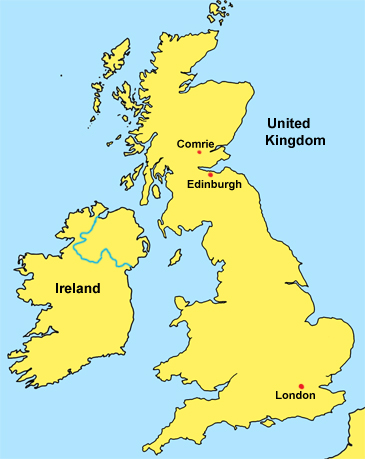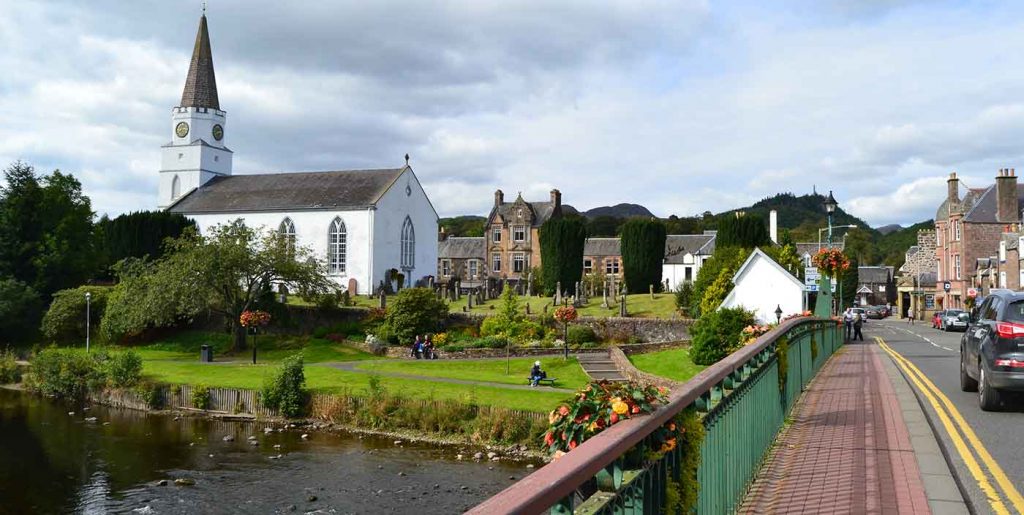 Chris Korte's New Zealand Genealogy Project
Chris Korte's New Zealand Genealogy Project
Comrie, Perthshire, Scotland
About page
This page has information about 19th Century Comrie in Scotland. Comrie was the birth and wedding place of Isabella Brough before she migrated to Australia then New Zealand. Her father, William Brough, was a farmer and corn miller in the parish.
If you can provide additional information, or corrections, please contact (see Info menu).
Comrie
The village of Comrie in Perthshire, Scotland, lies on the banks of the River Earn nestled on the edge of the Scottish Highlands. The village itself is made up of a single long main street. Comrie is in the heart of the scenic West Strathearn area of Perthshire, situated at the meeting of Glens Lednock and Artney, with the Scottish Highlands rising to the north.
The population of Comrie is now about 1800, considerably less than historically. The decline is due to the presence of a high proportion of elderly residents, the dwindling of the old estates and farm mechanization.
Comrie is pronounced "Cumry" with the emphasis on the first syllable. This lovely Perthshire town sits astride the geological "Highland Fault Line" and minor earth tremors are not infrequent. The Museum of Tartans is located here.
The focal point of the village is the "White Church" built in 1805. Previously a historic church, the building was refurbished and opened as "Comrie Community Centre" in 2000.


Comrie Village from the Dalingross Bridge over the River Earn.
White Church on left.
19th Century Comrie
The following extracts from THE NEW STATISTICAL ACCOUNT OF SCOTLAND give an idea of life in 19th Century Comrie. The following is extracted from the Comrie Parish article written in June 1838 by Rev. William MacKenzie, the parish minister of Comrie.
Extent - The parish is about 13 miles long and 10 broad, and contains about 130 square miles. This parish, lying at the head of Strathearn, is bounded by high mountains on three sides, the east opening on the valley of Strathearn. The principal range of mountains is the Grampians, running from south-west to north-east. Benhonzie is 2900 feet above the level of the sea, and Ben Vorlich, the highest, is 3300, and may be seen from Perth, Edinburgh, and Ayrshire. There is very little low or flat land in the parish; the principal valleys Glenartney, Glen Lednock, and the banks of the Earn are from 200 to 350 feet above the level of the sea, and they open up on the village of Comrie.
Hydrography - Loch Earn, the only considerable body of water in the parish, is 7 miles long, from 1 to 1½ broad, and its depth, in common with some other Scottish lakes, is very great, in many parts about 100 fathoms.
Earthquakes - This parish has acquired some notoriety from its earthquakes. These very remarkable phenomena have undoubtedly been felt here at intervals for nearly fifty years, but of late have been very feeble and rare. The writer of this felt one earthquake very distinctly, and has heard of several others during his incumbency. At and after the time of the last Statistical Account, the earthquakes were so frequent and violent, and accompanied with such loud noises, as to occasion great alarm.
Church - The parish church is a plain, substantial building, with a spire, forming a striking feature in the landscape. Having been built in 1805 it is in good repair. The accommodation is for 1044 sitters.
Population - The amount of population, so far as it can be traced, has varied little for upwards of a century. At the 1831 Census there were 2622 individuals. The number of families chiefly employed in agriculture was 221; chiefly employed in trade, manufactures, or handicrafts was 170; 586 total families. The village population at present amounts to 1666, and the country population to 1010.
Language - The English language is generally spoken, and has gained ground greatly within the last forty years. At present, scarcely a fourth part of the congregation attend on the afternoon Gaelic service, whereas forty years ago, the attendance on English was very limited.
Living conditions - A great improvement has taken place in the habits of the people, in respect of cleanliness in their persons and houses ; about three-fourths of their houses being slated, and plastered, and their dress being in general bought, not homespun, as formerly. Their ordinary food is potatoes, milk, and oatmeal. The use of wheat bread is becoming general, though no wheat is ever raised in the parish. There are three butchers, two brewers, three bakers, and more than twelve grocers. People are, on the whole, honest, sober, frugal, and industrious.
Agriculture - It is calculated that the number of acres, standard imperial measure, in the parish, which are either cultivated or occasionally in tillage, amounts to 7097 ; waste or in pasture 55,571; improvable, 1865; common or disputed, 1315; under wood, 3139. The tenant's principal dependence is stock, the preservation and improvement of it is his chief object. The general husbandry, in the pasture farms, is alternate white and green crops, and long rested as pasture. In the low grounds, the usual system is a rotation of five years, in the order of oats, green crop, barley, and grass seeds, — hay pasture. There is no wheat grown in the parish. The soil is excellently adapted for potatoes, barley, and oats, and, if largely manured, produces heavy crops.
Manufactures - The manufacture of cotton and woolen cloth is carried on in this parish. The hand-loom cotton weavers are employed by houses in Glasgow and Perth. During the winter months, 136 hand-loom weavers are employed; and of these one- tenth are employed only during three months of winter. The only woolen manufacture is carried on at the river Lednock, in the village of Comrie. Eleven men and eight children are employed at the mill, and five persons are employed out-of-doors.
Education - According to the report sent to the General Assembly for 1836, there were seven schools in this parish, besides four Sabbath and three week-day evening schools, viz. one parochial school; two schools on teachers' own adventure; three supported in part by individual subscription; and one by subscription of the inhabitants of the district. The winter attendance at the seven day schools amounted to one in every five of the population. Besides the common branches taught in all the schools, the parish teacher instructs in Greek, French, and mathematics.
There are none between six and fifteen years of age who cannot read or write; and, so far as is known, there are no natives of the parish above fifteen years of age who cannot read or write.
Page last updated on 23 July 2018.







